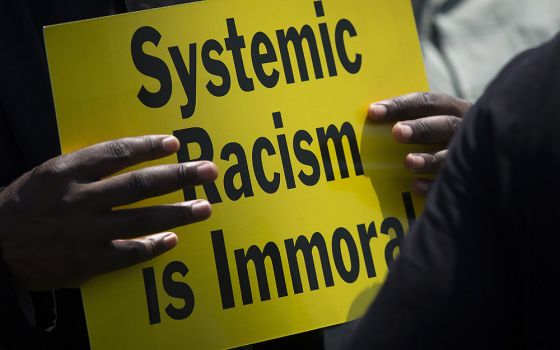Women religious and other Catholics in Detroit march during a Unite Our Nation procession Oct. 31. (CNS/Detroit Catholic/Dan Meloy)
Yesterday, when I was speaking with church leaders, one theme was constant: They hoped we would have a clear election result last night or early this morning. The country is so divided, the idea that there would be additional tension from not knowing who had won seemed too much to bear. We are now learning how to bear that burden.
Early in the night, it became obvious that former Vice President Joe Biden was unlikely to win Florida, the easiest way to bring the election to an end: There is almost no way for a Republican to win the presidency without Florida. Briefly, Texas looked close, but it turned out that the early vote results, which favored Biden, were the first numbers posted, and President Donald Trump quickly, and decisively, overtook the lead as same-day voting numbers came in. The dynamic in North Carolina seemed the same, although the race remains too close to call.
For a while, Ohio seemed like it might prove to be a surprise win for Biden, but at midnight the networks called it for Trump, and he won it by essentially the same margin he won it four years ago. The FiveThirtyEight.com final prediction had Ohio almost tied, with Trump at 49.8% to Biden's 49.2%. How could they be off by so much? Was this a repeat of 2016?
Every election night, I have a browser window open to the results as they come in, and a window open to David Leip's U.S. Election Atlas so I can see where the candidates are over- and under-performing for the races four and eight years previously. As I checked through key Florida counties, Biden was overperforming Clinton's 2016 numbers in most counties except Miami-Dade. Looking at Texas, Biden was outperforming 2016 in all the major metropolitan areas: Houston, Dallas, Austin, San Antonio. In Ohio's Cuyahoga, Franklin and Hamilton counties, Biden was doing as much as 10 points better than Clinton had done in 2016.
It turns out that when you started clicking on the small, rural counties in all these swing states, Trump was not only overperforming his numbers from 2016, but the total number of people who came out to vote was extraordinary. At midnight, neither candidate had flipped any state from its 2016 result, although it seemed Arizona was likely going to end up in the Biden column. The famous "Blue Wall" that crumbled in 2016 – Michigan, Pennsylvania and Wisconsin – were all too close to call.
It is shocking to think that this year's election turned out not to be a persuasion election. The pandemic. The economic downturn. The impeachment. The protests against racial injustice. The belief that the president's abrasiveness, his coarseness, his repugnant style, surely this would convince people to flee from him. Turns out this was a base election all along, and Trump, for all his flaws, was smart enough to recognize it as such.
As I write, we still do not know who is going to be our president for the next four years. But whoever wins, we know that the divisions in the country have been strengthened by the ratification the American electorate has just bestowed on them. We know Trump has no inclination to even try and unite the country. Biden was hoping a sweeping victory would start the process of healing those divisions, but there was no sweeping victory.
The challenge for the church is obvious, and it begins as all spiritual growth does with an examination of conscience. How have we contributed to this toxic culture? How have we furthered rather than ameliorated the divisions in our society? Was not this fraught national moment a predictable outcome of the culture-warrior model? Critically, and I think undeniably, we must ask ourselves if we have not mistakenly thought there were political solutions to cultural problems, and misdiagnosed the cultural problems we do face.
Advertisement
It is clear that half of the country fears change. For some, that fear may be rooted in racist anxieties about demographic changes. For some, economic dislocation has devastated their communities, where the only growth industry, tragically enough, is opioid production and distribution. The other half has no patience for people who fear change and have grown fearful of them in turn. And, to be honest, who among us these past few weeks has not trafficked in the fear we could easily generate at the prospect that our political opponent might win?
America is in a bad place, morally and spiritually, so we should not be surprised if that sickness of soul manifests itself politically. It has been a long time coming. Back in 1959, John Steinbeck sent a letter to Adlai Stevenson in which he wrote: "If I wanted to destroy a nation, I would give it too much and I would have it on its knees, miserable, greedy, and sick." He was commenting on the consumerist, winner-take-all attitudes of his day. How much more stuff have we been given since 1959?
We may not know yet who will win this election, but we know the work of healing this country is a task that belongs to us all. Whatever we have been trying in the past isn't working. The half of the nation that does not think like you has been unmoved by the events of the past four years.
If a pandemic is not enough to shake America out of its spiritual lethargy, what will it take? Maybe the 2020 election will go down in history as one more large step in the demise of the American nation. It is a hard prospect to contemplate, but I see no alternative this grim morning.
[Michael Sean Winters covers the nexus of religion and politics for NCR.]
Editor's note: Don't miss out on Michael Sean Winters' latest. Sign up and we'll let you know when he publishes new Distinctly Catholic columns.






